Serviços Personalizados
Journal
Artigo
Indicadores
-
 Citado por SciELO
Citado por SciELO -
 Acessos
Acessos
Links relacionados
-
 Citado por Google
Citado por Google -
 Similares em
SciELO
Similares em
SciELO -
 Similares em Google
Similares em Google
Compartilhar
Ciencia y Tecnología Agropecuaria
versão impressa ISSN 0122-8706versão On-line ISSN 2500-5308
Cienc. Tecnol. Agropecuaria vol.20 no.2 Mosquera maio/ago. 2019
https://doi.org/10.21930/rcta.vol20_num2_art:1460
Manejo de sistemas productivos
Effect of the associated application between Rhizobium leguminosarum and efficient microorganisms on common bean production
1Estudiante de doctorado de la Universidade Estadual Paulista “Júlio de Mesquita Filho” (unesp), Faculdade de CiênciasAgrarias e Veterinárias. São Paulo, Brasil. Correo
2Profesora, Universidad de Sancti Spíritus “José Martí Pérez”, Centro Universitario de Taguasco “Enrique José Varona”. SanctiSpíritus, Cuba.
3Investigadora, Empresa Agropecuaria Agroindustrial “Melanio Hernández”. Sancti Spíritus, Cuba.
4Estudiante de doctorado, Universidade Estadual Paulista “Júlio de Mesquita Filho” (unesp), Faculdade de Ciências Agrariase Veterinárias. São Paulo, Brasil
5Estudiante de doctorado, Universidade Estadual Paulista “Júlio de Mesquita Filho” (unesp), Faculdade de Ciências Agrariase Veterinárias. São Paulo, Brasil
6Corporación Colombiana de Investigación Agropecuaria - Corpoica
To evaluate the relationship between different application forms of efficient microorganisms and the inoculation with Rhizobium in the morphological and productive behavior of common beans, an experiment at Cooperativa de Créditos y Servicios "Martires de Taguasco," Sancti Spíritus, Cuba, was developed from October 2012 to January 2013 using the Cuba Cueto cultivar. Two factors were evaluated, the first was the use of Rhizobium (without and with 1 kg/46 kg of seed), and the second was four application forms of efficient microorganisms, without (0), to the furrow (100 mg/L), foliar (100 mg/L) and the associated (furrow plus foliar). The morphological and productive indicators established were: the average number of leaves per plant, plant height (cm), legumes per plant, grains per legumes, the mass of 100 grains (g/100 seeds), and yield (t/ha). The results showed that the best form of efficient microorganisms application was the associated form (furrow plus foliar) compared with the others, as it increased in 153.23 % the morphological and productive parameters evaluated, such as leaf production, plant height, legumes per plant, grains per legumes, mass of 100 seeds and grain yield when they were not inoculated with Rhizobium. Likewise, these same parameters increased 100 % when inoculated with Rhizobium and compared to the control treatment.
Keywords biofertilizers; crop yield; foliar application; Phaseolus vulgaris; seed inoculation; soil inoculation
Con el objetivo de evaluar la asociación entre diferentes formas de aplicación de microorganismos eficientes y la inoculación con Rhizobium en el comportamiento morfológico y productivo del fríjol común, se desarrolló un experimento en la Cooperativa de Créditos y Servicios “Mártires de Taguasco”, Sancti Spíritus, Cuba, de octubre de 2012 a febrero de 2013, y se utilizó el cv. Cuba cueto. Fueron evaluados dos factores: el primero fue la utilización de Rhizobium (sin y 1 kg/46 kg de semilla) y el segundo fue cuatro formas de aplicación de microorganismos eficientes, sin (0), al surco (100 mg/L), foliares (100 mg/L) y la asociada (surco más la foliar). Los indicadores morfológicos y productivos que se determinaron fueron los siguientes: promedio de hojas por plantas, altura de las plantas (cm), legumbres por plantas, granos por legumbres, masa de 100 granos (g/100 semillas) y rendimiento (t/ha). Los resultados mostraron que la aplicación asociada al surco más la foliar de microorganismos eficientes comparadas con las otras formas incrementó los parámetros morfológicos y productivos evaluados, como la producción de hojas, la altura de la planta, las legumbres por planta, los granos por legumbre, la masa de 100 semillas y el rendimiento del grano en 153,23 %, cuando no fueron inoculadas con Rhizobium, y 100 %, con la inoculación en relación con el tratamiento control.
Palabras clave aplicación foliar; biofertilizantes; inoculación de semillas; inoculación del suelo; Phaseolus
Introduction
Common bean (Phaseolus vulgaris L.) cultivation shows an incalculable value for human nutrition because it is an essential source of proteins and is part of the feeding habits of many persons in less developed countries. In Cuba, soil and climate conditions favor its cultivation, leading to its establishment in most of the national territory (Expósito & García, 2011).
Human activities produce changes in land use generating severe degradation of the land with possible impacts on the environment, as well as on its environmental, social and economic sustainability (Araújo et al., 2013). The increase in bean consumption requires higher yields based on the increase of cropping areas and alternatives that improve yields, among which the fixation of atmospheric nitrogen in symbiosis with bacteria of the genus Rhizobium (R) —as an advantage to this crop— is highlighted (Rosas, 2003).
Land degradation causes the loss of microbial diversity (Araújo, Borges, Tsai, Cesarz, & Eisenhauer, 2014, Nunes et al., 2012). Microbial processes are essential for soil fertility and plant growth, since microorganisms mineralize, oxidize, reduce and immobilize mineral and organic materials in the soil (Kennedy & Doran, 2003).
There are microorganisms such as bacteria of the genus Rhizobium that fix nitrogen in symbiosis with leguminous plants. Authors have estimated that the most substantial amount of atmospheric nitrogen fixed is the product of this association (Richards, 1987). Sessitsch, Howieson, Perret, Antoun, and Martínez-Romero (2002) estimated that around 80 % of the N2 fixed on the planet is produced by the bacterial activity of the Rhizobium genus. The use of commercial inoculants based on Rhizobium is a widespread practice for farmers to increase yields with low costs.
The use of native strains of Rhizobium as biofertilizers contributes to the maintenance of soil biodiversity, by reducing the negative impacts of mineral fertilizers (Nkot et al., 2015; Ouma, Asango, Maingi, & Njeru, 2016) and has a faster effect compared to organic fertilizer (Abdel-Fattah, Shukry, Shokr, & Ahmed, 2016). As an alternative to improve grain production, the use of efficient microorganisms (em) is recommended. em are a set of fermentation fungi, bacteria, and lactobacilli with multiple applications in the environmental, livestock and agricultural areas. These establishes a microbiological equilibrium of the soil and improves its quality, which increases crop production and protection, conserves natural resources and creates sustainable agricultural systems (Higa, 1994, 1995).
Moreover, em also produces substances that are beneficial to animal and plant life. Pedraza et al. (2010) reported that the fundamental principle of this technology is the increase of a group of beneficial soil microorganisms aiming at improving the conditions of the soil, eliminating putrefaction (including diseases), and optimizing the use of organic matter for the crops.
So far, the biostimulant effect of inoculation with Rhizobium and the use of em independently have been proven. However, the relationship or association that can be established between these biofertilizers has not been studied to a large extent; further, very little information is available on the effect that can be achieved on common bean plants. Based on these assumptions, the general aim of this research consisted of evaluating the association between different forms of em application and inoculation with Rhizobium in the morphological and productive behavior of common beans.
Materials and methods
Study site and plant material
The experiment was developed in the facilities of Cooperativa de Créditos y Servicios “Mártires de Taguasco,” located in the municipality of Cabaiguán, Sancti Spíritus, Cuba (coordinates 22°06'17.588" N and 79°22'33.544" W), from October 2012 to February 2013. The seeds of the common bean cultivar Cuba Cueto (CC-25-9-N) were obtained from the company Empresa de Semillas de Sancti Spíritus, with 96 % germination. The planting distance used was 0.60 m between rows and 0.08 m between plants to obtain around 200,000 plants per hectare.
General climatic conditions
The research was carried out during the last months of 2012 and the first months of 2013, in a flat plain agroecosystem (90 m.a.s.l) in the rainy to slightly rainy crop cycle. The agroecosystem under study is geographically located in the tropical climatic belt that also includes the archipelago and the Western Caribbean climatic sub-region. In the study area and based on the analysis of the climatic variables of the months considered in this study (figure 1), the existence of an appropriate climate for the development of common bean cultivation was confirmed. There were significant fluctuations in average monthly temperatures, which were very favorable for the different phenological stages of the crop, such as flowering, fruiting and grain filling (Socorro & Martín, 1989).
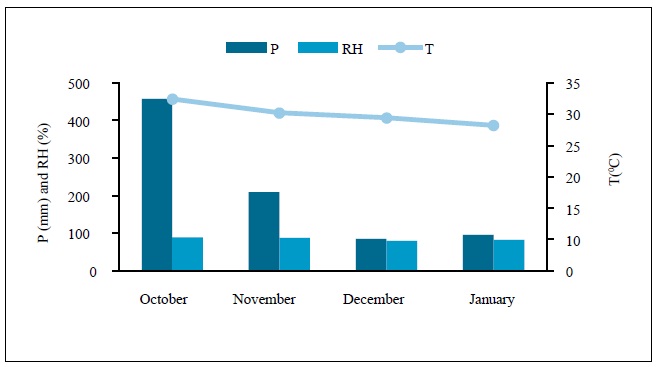
Source: Elaborated by the authors
Figure 1 Histogram of monthly average values of climatological variables from the study area.P: Precipitation; T: Average temperature; rh: Relative humidity. Data provided by Centro Meteorológico Provincial (cmp) of SanctiSpíritus-Citma (2013)
The average monthly rainfall for the developmentof the study favored the development of the firstplant stages such as germination, and the vegetativedevelopment stages. Rainfall in December was lowerthan the optimal for this crop, but it favored a waterbalance for the maintenance of flowering, fruitingand grain filling, complemented by the rains in thefirst days of January (Quintero, 1996). It must beunderlined that there was no water deficit because thearea was irrigated twice to maintain soil humidity.
The relative humidity had an adequate and favorablebehavior for the minimum occurrence of diseasesand an adequate plant development because theaverage monthly values were close to 80 % to obtainoptimum yields (Quintero, Gil, Ríos, Martínez, &Díaz, 2006).
Experimental design and treatments
A randomized block design in a factorial scheme of 2 × 4 was used. The factors considered were the following: inoculation of the seeds with Rhizobium (R) (seeds not inoculated, and seeds inoculated with Rhizobium at a rate of 1 kg/46 kg of seed; previous seed pelletization was carried out before sowing), and application of effective microorganisms (em) (four application forms, including a control without application, direct application to the furrow (100 mg/L), foliar application to plants (100 mg/L), and combined application of em to furrows and foliar). Additionally, four blocks were established to have a total of 32 plots.
The applications of em in the furrows were carried out before planting the seeds; subsequently, seeds were deposited and covered with soil. The foliar treatments began from the appearance of the first true leaves in the growth and development stages of the crop, i.e., V2, V3, and R5.
Characteristics of the cultivar
The common bean cultivar Cuba Cueto (CC-259-N) has black grains with a yield potential of 2.7 t/ha; it has a type III growth habit and a cycle of 75 to 80 days. Sowing management, phytosanitary control, irrigation, among other practices, were carried out according to the technical manual for its cultivation (Faure et al., 2014).
Type of soil and main features
The soil of the experimental unit is classified as Sialitic Brown, with carbonate showing an abc profile of medium depth, a dark brown color in dry state, and bluish green under wet conditions product of the iron oxidation process (Hernández, Pérez, Bosch & Castro, 2015); internationally it is known as Cambisol (Schad, 2016). This soil group is considered as a heavy soil with high presence and predominance of clay of type 2:1. In its dry state, cracks can be observed on the surface as a result of the contraction process of the clay, and in its wet state, it is very plastic, making agricultural work difficult. These conditions generally occur due to poor drainage and compaction, and a laminar structure is visible on the surface. On the other hand, this type of soil can be found mainly in areas of low weathered plains, giving rise to young soils. However, one of the most significant limitations for young soils is the low effective depth and susceptibility to compaction. In this work, the average slope did not exceed 3 %, which is considered as not very undulating.
Characteristics of the biofertilizers
The strain of Rhizobium leguminosarum bv. phaseoli was obtained in the Provincial Soil Laboratory of Sancti Spíritus. The seeds were inoculated with a concentration of 2.5 109 cfu of R. leguminosarum. The inoculum of efficient microorganisms was composed of Bacillus subtilis B/23-45-10 Nato (5.4 104 cfu/mL), Lactobacillus bulgaricus B/103-4-1 (3.6 104 cfu/mL) and Saccharomyces cerevisiae L-25-7-12 (22.3 105 cfu/mL), with a quality certificate issued by Instituto Cubano de Investigaciones de los Derivados de la Caña de Azúcar (Icidca) [code R-ID-B-Prot-01-01]. It was acquired at the Labiofam Branch of Sancti Spíritus and was made according to the methodology proposed by Olivera, Ayala, Calero, Santana and Hernández (2014). The em inoculum was characterized according to López, Calero et al. (2017), as follows: dry matter 17.0 g/L; organic material 11.0 g/L; pH = 3.16; ammonia nitrogen (N-NH4 +) 0.03 mg/L; potassium (K+) 0.80 mg/L; phosphorus (H2PO4-) 0.83 mg/L; calcium (Ca2+) 24.05 mg/L, and magnesium (Mg2+) 4.86 mg/L.
Variables evaluated
The variables that were evaluated corresponded to the criteria exposed by descriptors recommended in the growth and development stages of the crop (Fernando, Gepts, & López, 1986). The samplings were carried out in plants sown in an area of 1 m2. The morphological indicators that were established were the average number of leaves per plant (alp), plant height (ph) in centimeters, number of legumes per plant (lp), number of grains per legume (gl), mass of 100 grains (g/100 seeds) (mg), and yield (t/ha).
Statistical analysis
The software AgroEstat® was used to analyze the results obtained (Barbosa & Maldonado-Junior, 2015). The normality of the variables was checked through a descriptive analysis of continuous and quantitative variables using the Kolmogórov-Smirnov test (Allen, 1976) and subjected to an analysis of variance; the significance of the variance was checked through the F-test. The means were compared through Tukey’s multiple range test with α of 0.05.
Results and discussion
Effect on morphological parameters
The alp was significantly (p < 0.05) higher in the treatments with Rhizobium inoculated seeds compared to the non-inoculated treatments (figure 2). High significance was found in the interaction between r · em; besides, all forms of em applied stimulated alp in the common bean cv . Cuba Cueto, both in plants inoculated and not inoculated with Rhizobium. Moreover, the associated em application (Furrow + Foliar) increased the alp in plants inoculated with Rhizobium (65.85 %) as well as in those that were not inoculated (92.12 %), compared to all the other application forms assessed.
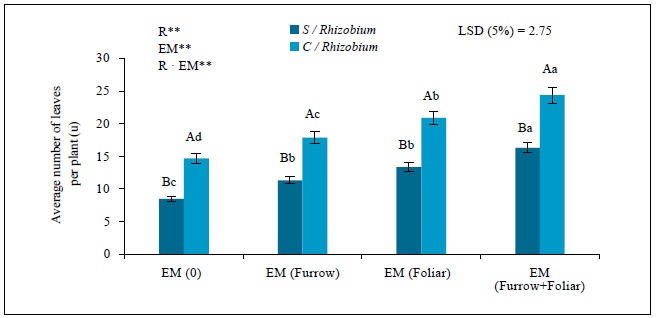
Source: Elaborated by the authors
Figure 2. Effect of Rhizobium (0 [S/Rhizobium] and 1 kg in 46 kg of seed [C/Rhizobium]) and efficientmicroorganisms (0, furrow 100 mg/L, foliar 100 mg/L, and the association between furrow and foliar) in theaverage number of leaves per plant in common bean cv. Cuba Cueto. r: Rhizobium; em: Efficient microorganisms;and r · em: Interaction between r and em. Values are represented by means ± sd (n = 5).Capital letters differ between the Rhizobium application, and lowercase letters differ between the em applications usedaccording to Tukey (p ≤ 0.05); CV (%) = 7.82; SE (±) = 0.66.** Significant at a 99 % confidence level.
Individual or associated inoculation of common bean with Rhizobium was efficient in promoting the increase in alp (figure 2). This beneficial effect of inoculation with Rhizobium in common bean plants was reported by González, Sosa and Díaz (2012), who achieved increases in the number of trifoliate leaves by 14.58 compared to the control without inoculation. In this sense, Marín, Mena, Chaveli, Morán and Pimentel (2013), with the association between Tsukamurella paurometabola C-924 and R. leguminosarum in common beans, were able to significantly stimulate the number of leaves compared to the control without inoculation.
The application of the em individually or in combination promoted the alp in common bean plants. This result occurs mainly because the foliar em application improves foliage growth (22 %) (Díaz, Montero, & Lagos, 2009). Therefore, the photosynthetic area of the plants is increased translating this into a higher elaboration of nutrients for the plant and, hence, in an increase of its productivity. Nevertheless, the effect of em has been demonstrated in common bean plants (Calero et al., 2018; Quintero, Calero, Pérez, & Enríquez, 2018).
The results for ph showed significant differences (p < 0.05) between the evaluated factors, with high significance between the r · em interaction (figure 3). This indicator was benefited by the inoculation of the seeds with Rhizobium compared to the non-inoculated seeds. All em application forms stimulated the growth of the plants independently of whether these were inoculated or not with Rhizobium. The em associated treatment (furrow + foliar) was the best compared to the other application forms used. Comparing the ph values of those plants that were not treated with Rhizobium in the associated treatment with em (Furrow + Foliar) this value increased 28.00 % compared to the foliar application, 43.37 % compared to the direct application to the furrow, and 72.29 % compared to the control. Whereas, when the seeds were inoculated with Rhizobium, the increases were 20.84 % compared to direct applications to the furrows and the foliar application, and 36.50 % compared to the control treatment.
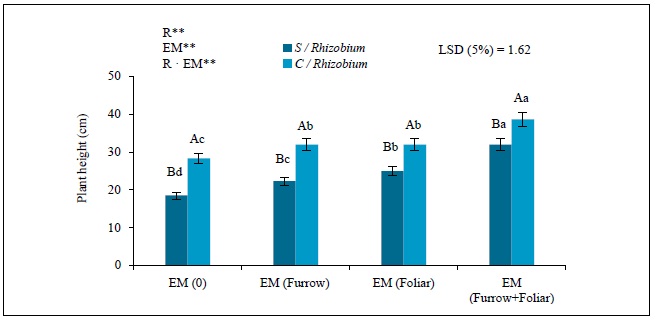
Source: Elaborated by the authors
Figure 3. Effect of Rhizobium (0 [S/Rhizobium] and 1 kg in 46 kg of seed [C/Rhizobium]) and em (0, furrow 100mg/L, foliar 100 mg/L and the association between furrow and foliar) in the average plant height in common beancv. Cuba Cueto. r: Rhizobium; em: Efficient microorganisms; and r · em: interaction between r and em.Values are represented by means ± sd (n = 5). Uppercase letters differ between Rhizobium applications and lowercase lettersdiffer among the em applications carried out, according to Tukey (p < 0.05); cv (%) = 6.38; se (±) = 0.39.** Significant at a 99 % confidence level.
The beneficial effect of using Rhizobium on the growth of common bean plants was evidenced, due to the increase in alp, especially with the application of em (Furrow + Foliar) (figure 2). This positive effect of Rhizobium inoculation on common bean plants was also found by González et al. (2012), who obtained plants with an average height of more than 26.81 cm compared to the control without inoculation.
The effect of the application of em was observed in the increase in ph (figure 2). This growth occurs because when the em are related to the organic matter, they produce useful substances such as vitamins, organic acids, chelated minerals, and antioxidant substances, which favor the development and growth of crops (Pérez, 2010). The effect of the em in the increase in alp has also been found in common bean plants (Calero et al., 2018; Quintero et al., 2018); furthermore, the alp of common bean cv. Bat-304 plants have achieved increases of 74.0 % (Calero, Pérez, & Pérez, 2016). On the other hand, López, Gil, Henderson, Calero and Jiménez (2017) achieved increases in onion ph with the combined application of em together with effluents from a biogas plant compared to untreated plants.
Effect on performance and its components
The average number of lp in the cv. Cuba Cueto had a significant effect (p < 0.05) with high interaction between the r · em factors (figure 4). Plants inoculated with Rhizobium showed higher responses compared to those that were not inoculated. The highest results for this indicator were obtained by the em associated treatment (Furrow + Foliar) in comparison with the other forms of em application, either for plants inoculated or not with Rhizobium. The increases in plants not treated with Rhizobium were 37.82 % compared to the application in furrows and the foliar application, and 81.19 % compared to the control treatment (without application of em). Meanwhile, in plants inoculated with Rhizobium, the em association reached increases of 13.97 % compared with individual furrow and foliar applications, and 37.07 % compared to the control treatment.
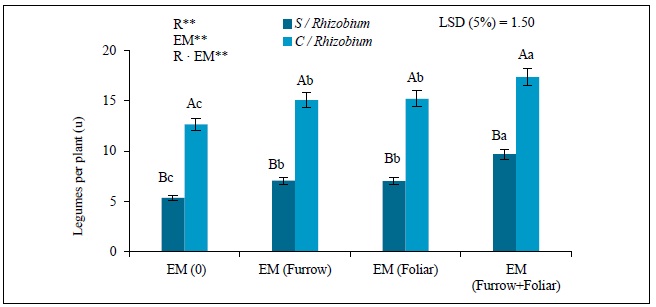
Source: Elaborated by the authors
Figure 4. Effect of Rhizobium (0 [S/Rhizobium] and 1 kg in 46 kg of seed [C/Rhizobium]) and em (0, furrow100 mg/L, foliar 100 mg/L and the association between furrow and foliar) in the average production of legumesper plant in common bean cv. Cuba Cueto. r: Rhizobium; em: efficient microorganisms; and r · em: interactionbetween r and em. Values are represented by means ± sd (n = 5).Capital letters differ between the Rhizobium application, and lowercase letters differ between the em application forms used,according to Tukey (p < 0.05); cv (%) = 5.73; se (±) = 0.36.** Significant at a 99 % confidence level.
The production of legumes per plants is an important yield component. The association between em and Rhizobium achieved a higher and better distribution of this indicator in the entire plant compared to untreated plants. This concentrated pod production in the central part of the plant was greatly affected by humidity, temperature, and the agrotechnical work carried out on the crop during its development.
The inoculation with Rhizobium favored the production of lp in the cv. Cuba Cueto. This increase could be influenced by the increase in alp and ph (figures 2 and 3), a fact also observed in common bean by González et al. (2012) and Mercante, Otsubo and Brito (2017). Additionally, significant increases in the number of lp in this crop with the inoculation of the seeds with Rhizobium were reported by Abdel-Fattah et al. (2016).
The application of em benefited the production of lp, mainly in the associated application (Furrow + Foliar), because the common bean plants reached higher alp and ph values. The beneficial effect of em favoring the development and production of fruits (lp) was observed in common bean plants by Calero et al. (2018) and Quintero et al. (2018). On the other hand, Calero et al. (2016) reported an increase of eight legumes per plant with the associated application between em and FitoMas-E, in comparison to the control treatment.
The average number of gl was significantly higher (p < 0.05) when seeds were inoculated with Rhizobium compared to non-inoculated seeds, with high interaction between Rhizobium and em factors (figure 5). All the em forms used stimulated the average number of gl compared to the control without application of em. The highest average values were reached when em was applied associated (Furrows + Foliar) with or without inoculation of seeds with Rhizobium. When the seeds were not treated with Rhizobium, the associated application of em exceeded in 43.81 % the values found with individual furrow and foliar applications, and in 111.27 % compared to the control treatment. On the other hand, when the seeds were inoculated with Rhizobium, the associated use of em (Furrow + Foliar) increased the number of gl in 19.34 % compared to the individual em application to furrows and foliar, and in 44.84 % compared to the control treatment.
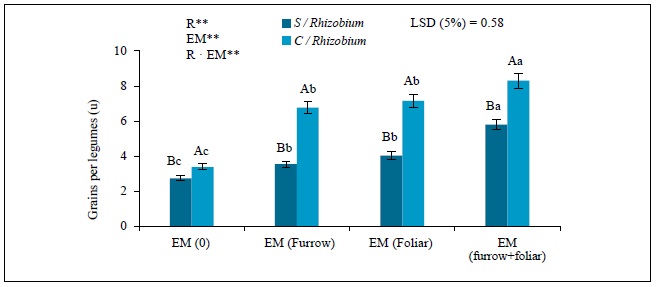
Source: Elaborated by the authors
Figure 5. Effect of Rhizobium (0 [S/Rhizobium] and 1 kg in 46 kg of seed [C/Rhizobium]) and em (0, furrow 100mg/L, foliar 100 mg/L and the association between furrow and foliar) in the average number of grains per legumesin common bean cv. Cuba Cueto. r: Rhizobium; em: efficient microorganisms; and r · em: interaction between rand em. Values are represented by means ± sd (n = 5).Capital letters differ between Rhizobium application, and lowercase letters differ among the em application forms used,according to Tukey (p ≤ 0.05); cv (%) = 4.87; se (±) = 0.14.** Significant at a 99 % confidence level
The filling of the legumes was favored by the behavior of the temperature and the relative humidity in the study area during the development of the experiment, but the treatment of the seeds with Rhizobium favored, even more, the production of Gl, especially by the increase of the alp and the ph. This beneficial effect of inoculation with Rhizobium in common bean plants cv. Cuba Cueto was also found by González et al. (2012), who reached a higher average of 2.12 grains per plant compared to the control without inoculation.
Furthermore, the application of em had a positive effect on the gl average, especially when the em were applied in the associated form (Furrow + Foliar), because they increased the morphological indicators such as the alp, the ph and the number of lp (figures 2, 3 and 4). The results of the beneficial effect of em in common bean plants were also observed by Calero et al. (2018) and Quintero et al. (2018). On the other hand, Calero et al. (2016) observed an increase of 67.07 % in the average number of gl, by combining the foliar applications of em with FitoMas-E and Lebame, compared to the treatment without application of em.
The mass of 100 grains was stimulated significantly (p < 0.05) when the seeds were inoculated with Rhizobium in comparison to the non-inoculated seeds, and a high interaction was observed with different treatments with em (figure 6). The highest average values were obtained with the associated application of em (Furrow + Foliar) in treatments with or without Rhizobium. When the seeds were not treated with R. leguminosarum, the increases obtained by the treatment with associated em (Furrow + Foliar) compared to the individual application forms to the furrow and foliar were 18.61 %, and 42.88 %, respectively, in comparison to the control treatment. Regarding the inoculation of the seeds with Rhizobium, the associated applications of em exceeded the foliar and furrow individual application forms in 7.41 %, and 16.41 %, respectively, compared to the control treatment.
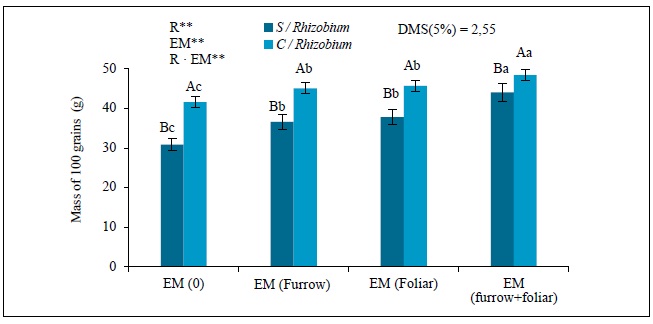
Source: Elaborated by the authors
Figure 6. Effect of Rhizobium (0 [S/Rhizobium] and 1 kg in 46 kg of seed [C/Rhizobium]) and em (0, furrow 100mg/L, foliar 100 mg/L and the association between furrow and foliar) in the average mass of 100 grains in commonbean cv. Cuba Cueto. r: Rhizobium; em: efficient microorganisms; and r · em: interaction between r and em.Values are represented by means ± sd (n = 5).Capital letters differ between Rhizobium application and lowercase letters differ among em application forms used, accordingto Tukey (p ≤ 0.05); cv (%) = 7.59; se (±) = 0.62.** Significant at a 99 % confidence level.
The mass of 100 grains is closely related to agricultural yield. In this work, inoculation with Rhizobium reached the highest values of this indicator and coincided with the highest yields, mainly because the alp, the ph, the number of lp and the number of gl increased (figures 2, 3, 4 and 5). In this sense, Ponce, Ortiz, de la Fé and Moya (2002) indicated that this parameter contributes to defining planting rules, and shows the possible number of seeds and plants that can be obtained, depending on the mass.
The positive effect of inoculation with Rhizobium on common bean seeds was reported by González et al. (2012), by increasing the association between Rhizobium and mycorrhizae in comparison to the control treatment by 27.60 g and 11.59 g, respectively. According to Mercante et al. (2017), the mass of 100 grains in common bean plants inoculated with Rhizobium was similar to plants fertilized with nitrogen at a rate of 80 kg/ha.
In common bean plants cultivated with or without inoculation with Rhizobium, the application of em, especially the treatment with the associated form (Furrow + Foliar), generated an increase in alp, ph, lp, and gl. These positive effects caused by em in common bean plants were also reported by Calero et al. (2018) and Quintero et al. (2018). On the other hand, Calero et al. (2016) showed that with the associated application of em with FitoMas-E and with Lebame, an increase in the size and mass of 100 grains compared to the treatment without application could be obtained.
The productivity of cv. Cuba Cueto was significantly higher (p < 0.05) when the seeds were inoculated with Rhizobium compared to the non-inoculated ones. High interaction between the studied factors was detected (figure 7). Note how yield was higher in the treatments with the associated application of em compared to the other forms of application and the control treatment, when treating or not the seeds with Rhizobium. The results of the combined application of em exceed the average yield values in 49.53 % of the treatments compared to the individual em application forms, and in 153.23 % compared to the control treatment when the seeds were not inoculated. Meanwhile, when the seeds were treated with Rhizobium the increases were of 26.53 % compared with the individual furrow and foliar applications, and in 100 % when compared to the control treatment.
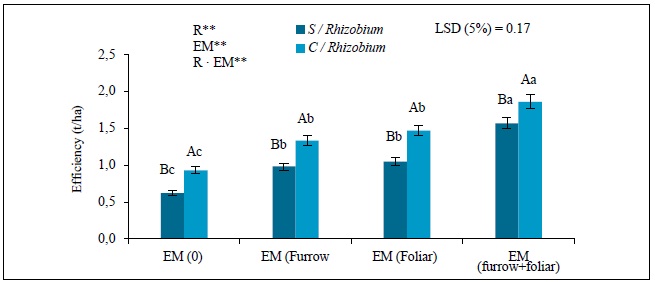
Source: Elaborated by the authors
Figure 7. Effect of Rhizobium (0 and 1 kg in 46 kg of seed) and em (0, furrow 100 mg/L, foliar 100 mg/L andthe association between furrow and foliar) in the average yield in cv. Cuba Cueto. r: Rhizobium; em: efficientmicroorganisms; and r · em: interaction between r and em. Values are represented by means ± sd (n = 5).Capital letters differ between Rhizobium application and lowercase letters differ among the em application forms used,according to Tukey (p ≤ 0.05); cv (%) = 5.68; se (±) = 0.04.** Significant at a 99 % confidence level.
The inoculation of common bean seeds with Rhizobium increased grain yield due to the increase in morphological parameters such as alp and ph (figures 2 and 3), and also in yield components such as the average number of lp, gl, and the mass of 100 grains (figures 4, 5 and 6). These results corroborate the criteria set forth by Díaz et al. (2009), who point out that em can be used as soil inoculants to rebuild its biological balance, improve the availability and assimilation of nutrients and, in this way, favor plant growth, productivity, and protection. This beneficial effect of Rhizobium on bean productivity increase was also found by González et al. (2012), who obtained an increase of 1.34 t/ha compared to plants without inoculation.
In common bean plants treated with or without Rhizobium, the application of em increased grain yield, especially with the associated em treatment (Furrow + Foliar), because it increased the indicators assessed such as alp, ph, lp, gl, and the mass of 100 grains (figures 2, 3, 4, 5 and 6), compared with the individual application forms and with the treatment without the application of em. This fact was reported in common bean plants by Calero et al. (2018) and Quintero et al. (2018). Further, the study carried out by Calero et al. (2016) obtained with the associated application of em with FitoMas-E and with Lebame, increases plant yield in 1.0 t/ha compared to the control treatment.
Conclusions
The inoculation of the common bean cv. Cuba Cueto seeds with Rhizobium benefited the behavior of the morphological and productive indicators evaluated compared to those that were not inoculated with this biofertilizer.
The highest results in the production of common bean were achieved with the associated application of effective microorganisms (directly in furrows and foliar) in comparison with the individual application forms in furrows and foliar, and with or without inoculating seeds with Rhizobium. The increases when the seeds were not inoculated with Rhizobium were 92.12 % in leaf production, 72.29 % in plant height, 81.19 % in the average number of legumes per plant, 111.27 % in the average number of grains per legume, 42.88 % of the mass of 100 grains, and 153.23 % in grain yield, in comparison to the control treatment. On the other hand, when the seeds were inoculated with Rhizobium, the increases were 65.85 % in leaf production, 36.50 % in plant height, 37.07 % in the average number of legumes per plant, 44.84 % in the average number of grains per legumes, 16.41 % in the mass of 100 grains, and 100 % in grain yield compared to the control treatment.
Acknowledgments
The authors wish to thank the Labiofam Branch and Laboratorio Provincial de Suelo of Sancti Spíritus for offering the biofertilizers used in this study free of charge. Also, the authors want to thank Cooperativa de Créditos y Servicios “Mártires de Taguasco” for their support in the acquisition of resources to support the field work in this study. Moreover, many thanks to the peer reviewers and the editors of this journal for their comments, which helped improve this work.
REFERENCES
Abdel-Fattah, G. M., Shukry, W. M., Shokr, M. M., & Ahmed, M. A. (2016). Application of mycorrhizal technology for improving yield production of common bean plants. International Journal of Applied Sciences and Biotechnology, 4(2), 191-197. doi:10.3126/ijasbt.v4i2.15103. [ Links ]
Allen, M. E. (1976). Kolmogorov-Smirnov test for discrete distributions (tesis de maestría). Naval Postgraduate School. Monterey, California. Recuperado de https://www.calhoun.nps.edu/handle/10945/17830 [ Links ]
Araújo, A. S., Borges, C. D., Tsai, S. M., Cesarz, S., & Eisenhauer, N. (2014). Soil bacterial diversity in degraded and restored lands of Northeast Brazil. Antonie van Leeuwenhoek, 106(5), 891-899. doi:10.1007/s10482014-0258-5. [ Links ]
Araújo, A. S., Cesarz, S., Leite, L. F., Borges, C. D., Tsai, S. M., & Eisenhauer, N. (2013). Soil microbial properties and temporal stability in degraded and restored lands of Northeast Brazil. Soil Biology and Biochemistry, 66, 175181. doi:10.1016/j.soilbio.2013.07.013. [ Links ]
Barbosa, J. C., & Maldonado-Junior, W. (2015). Experimentação agronômica e AgroEstat®: sistema para análises estatísticas de ensaios agronômicos [software]. Universidade Estadual Paulista “Júlio de Mesquita Filho”, Campus de Jaboticabal, São Paulo, Brasil. [ Links ]
Calero, A., Quintero, E., Olivera, D., Pérez, Y., Castro, I., Jiménez, J., & López, E. (2018). Respuesta de dos cultivares de frijol común a la aplicación foliar de microorganismos eficientes. Cultivos Tropicales, 39(3), 5-10. [ Links ]
Calero, A., Pérez, Y., & Pérez, D. (2016). Efecto de diferentes biopreparados combinado con FitoMas-E en el comportamiento agroproductivo del frijol común (Phaseolus vulgaris L.). Monfragüe Desarrollo Resiliente, 7(2), 161-176. Recuperado de https://www.eweb.unex.es/eweb/monfragueresilente/numero14/Art7.pdf [ Links ]
Díaz, O. A., Montero, D. M., & Lagos, J.A. (2009). Acción de microorganismos eficientes sobre la actividad de intercambio catiónico en plántulas de acacia (Acacia melanoxylon) para la recuperación de un suelo del municipio de Mondoñedo, Cundinamarca. Revista Colombia Forestal, 12, 141-160. Recuperado de https://www.scielo.org.co/pdf/cofo/v12n1/v12n1a10.pdf. [ Links ]
Expósito, I. R., & García, I. N. (2011). Comportamiento productivo de cultivares de frijol negro (Phaseolus vulgaris, L.) en la Cooperativa de Créditos y Servicios “José Manuel Rodríguez" del Municipio Jesús Menéndez. Observatorio de la Economía Latinoamericana, 153, 1–32. Recuperado de https://www.econpapers.repec.org/article/ervobserv/y_3a2011_3ai_3a153_3a1.htm [ Links ]
Faure, B., Benítez, R., Rodríguez, E., Grande, O., Torres, M., & Pérez, P. (2014). Guía Técnica para la producción de frijol común y maíz. La Habana, Cuba: Instituto de Investigaciones en Fruticultura Tropical (Inifat). [ Links ]
Fernando, F., Gepts, P., & López, M. (1986). Etapas de desarrolla de la planta de frijol común (Phaseolus vulgaris L.). Cali, Colombia: Centro Internacional de Agricultura Tropical (ciat). [ Links ]
González, R. L., Sosa, B. N., & Díaz, R. B. (2012). Efecto de la aplicación de Rhizobium y Mycorriza en el crecimiento del frijol (Phaseolus vulgaris L.) variedad CC-25-9 negro. Centro Agrícola, 39(4), 17-20. [ Links ]
Hernández, A., Pérez, J. M., Bosch, D., & Castro, N. (2015). Clasificación de los suelos de Cuba. La Habana, Cuba: Instituto Nacional de Ciencias Agrícolas (inca). [ Links ]
Higa, T. (1994). Beneficial and effective microorganisms for a sustainable agriculture and environment. TechnoTrends (Philippines), 9(4), 1-5. Recuperado de https://www.teraganix.com/category-s/1002.htm. [ Links ]
Higa, T. (1995). Studies on purification and recycling of animal waste using effective microorganism (em). Recuperado de https://www.emtech.org. [ Links ]
Kennedy, A. C., & Doran, J. W. (2003). Sustainable agriculture: role of microorganisms. En G. Bitton (Ed.), Encyclopedia of Environmental Microbiology (pp. 3116-3126). Nueva York, EE. UU.: Wiley & Sons. doi:10.1002/0471263397.env085. [ Links ]
López, E., Calero, A., Gómez, Y., Gil, Z., Henderson, D., & Jiménez, J. (2017). Efecto agronómico del biosólido en cultivo de tomate (Solanum lycopersicum): control biológico de Rhizoctonia solani. Cultivos Tropicales, 38(1), 13-23. [ Links ]
López, E., Gil, Z., Henderson, D., Calero, A., & Jiménez, J. (2017). Uso de efluente de planta de biogás y microorganismos eficientes como biofertilizantes en plantas de cebolla (Allium cepa L., cv. Caribe-71). Cultivos Tropicales, 38(4), 7-14. [ Links ]
Marín, M., Mena, J., Chaveli, P., Morán, R., & Pimentel, E. (2013). Interaction among Tsukamurella paurometabola C-924 and Rhizobium leguminosarum biovar phaseoli cfh in bean plants. Acta Agronómica, 62(1), 52-58. [ Links ]
Mercante, F. M., Otsubo, A., & Brito, O. R. (2017). New native Rhizobia strains for inoculation of common bean in the Brazilian Savanna. Revista Brasileira de Ciência do Solo, 41, 1-11. doi:10.1590/18069657rbcs20150120. [ Links ]
Nkot, L. N., Fankem, H., Adamou, S., Ngakou, A., Nwaga, D., & Etoa, F. X. (2015). Abundance of legume nodulating bacteria in soils of diverse land use systems in Cameroon. Universal Journal of Plant Science, 3(5), 97108. doi:10.13189/ujps.2015.030502. [ Links ]
Nunes, J. S., Araújo, A. S., Nunes, L. A., Lima, L. M., Carneiro, R. F., Salviano, A. A., & Tsai, S. M. (2012). Impact of land degradation on soil microbial biomass and activity in Northeast Brazil. Pedosphere, 22(1), 88-95. doi:10.1016/ S1002-0160(11)60194-X. [ Links ]
Olivera, D., Ayala, J., Calero, A., Santana, M., & Hernández, A. (2014). Prácticas agroecológicas en la provincia de Sancti Spíritus, Cuba. Microorganismos eficientes (em), una tecnología apropiada sobre bases agroecológicas. Ciencia, Tecnología, Sociedad (cts) para la construcción de la Agroecología, 7(1), 77 83. Recuperado de https://www.obmts.org/wp-content/uploads/2017/04/livroagroeclogiaCTS25-9-2014.pdf [ Links ]
Ouma, E. W., Asango, A. M., Maingi, J., & Njeru, E. M. (2016). Elucidating the potential of native rhizobial isolates to improve biological nitrogen fixation and growth of common bean and soybean in smallholder farming systems of Kenya. International Journal of Agronomy, 2016, Article ID 4569241. doi:10.1155/2016/4569241. [ Links ]
Pedraza, R., Teixeira, K., Fernández, A., García de Salamone, I., Baca, B., Azcón, R., ... Bonilla, R. (2010). Microorganismos que mejoran el crecimiento de las plantas y la calidad de los suelos. Corpoica Ciencia y Tecnología Agropecuaria, 11(2), 155-164. doi:10.21930/rcta.vol11_ num2_art:206. [ Links ]
Pérez, S. M. (2010). Efecto de microorganismos aplicados por fertirriego en la disponibilidad de fósforo en dos sistemas de cultivo de banano en la zona bananera del Magdalena (tesis de maestría). Universidad Nacional de Colombia. Santa Marta, Colombia. [ Links ]
Ponce, M., Ortiz, R., de la Fé, C., & Moya, C. (2002). Estudio comparativo de nuevas variedades de soya Glycine max (L.) Merr. para las condiciones de primavera en Cuba. Cultivos Tropicales, 23(2), 55-58. [ Links ]
Quintero, E. (1996). Manejo de algunos factores fitotécnicos en frijol común en condiciones de una agricultura sostenible (tesis de maestría). Universidad Central de Las Villas. Villa Clara, Cuba. [ Links ]
Quintero, E., Calero, A., Pérez, Y., & Enríquez, L. (2018). Efecto de diferentes bioestimulantes en el rendimiento del frijol común. Centro Agrícola, 45(3), 73-80. [ Links ]
Quintero, E., Gil, V., Ríos, H., Martínez, M., & Díaz, M. (2006). El fitomejoramiento participativo del frijol y su impacto en la introducción de caracteres positivos a los sistemas agrícolas de Villa Clara. Centro Agrícola, 33(3), 13-21. [ Links ]
Richards, B. N. (1987). The microbiology of terrestrial ecosystems. Harlow, Reino Unido: Longman Group UK Ltd. [ Links ]
Rosas, J. C. (2003). El cultivo del frijol común en América Tropical. Zamorano, Honduras: Escuela Agrícola Panamericana. [ Links ]
Schad, P. (2016). The International Soil Classification System wrb, Third Edition, 2014. En L. Mueller, A. Sheudshen & F. Eulenstein (Eds), Novel Methods for Monitoring and Managing Land and Water Resources in Siberia (pp. 563571). Cham, Suiza: Springer. doi:10.1007/978-3-31924409-9_25. [ Links ]
Sessitsch, A., Howieson, J. G., Perret, X., Antoun, H., & Martínez-Romero, E. (2002). Advances in Rhizobium research. Critical Reviews in Plant Sciences, 21(4), 323 378. doi:10.1080/0735-260291044278. [ Links ]
Socorro, M. A., & Martín, D. S. (1989). Frijol. En M. A. Socorro, & D. S. Martín (Eds.), Granos. (pp. 1-53). La Habana, Cuba: Editorial Pueblo y Educación. [ Links ]
Received: May 15, 2018; Accepted: January 30, 2019











 texto em
texto em 



